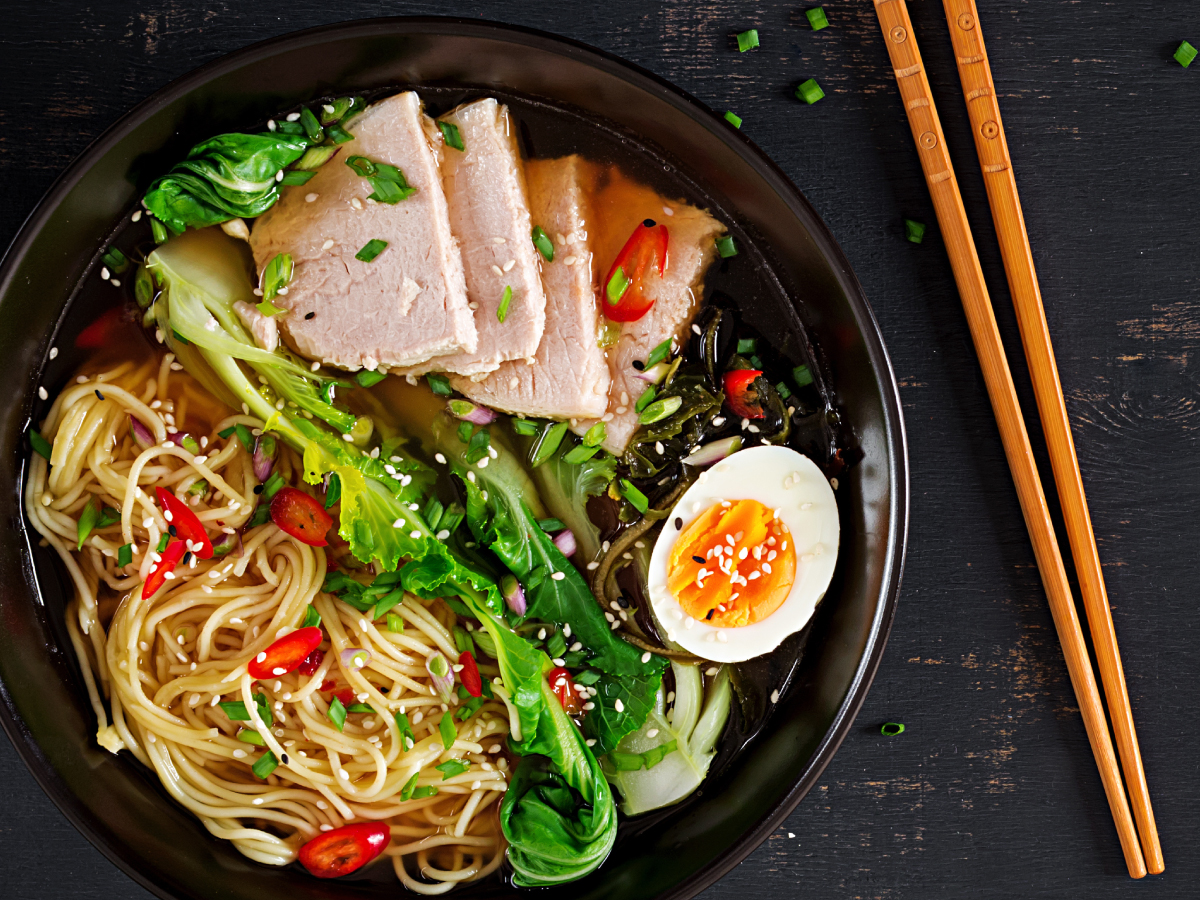What is Ramen?
Even without its singular past, ramen is a special dish for another reason: alkaline noodles. Ramen is essentially a soup consisting of a broth that is often pork-based, alkaline noodles, soy sauce, and various add-ins which change based on the region you’re getting them from. The noodles are made by combining wheat flour with alkaline water, or water that has been mixed with heat-treated baking soda thereby raising the PH and making the water (chemically speaking) more basic; this actually changes the structure of the noodles at the molecular level, giving ramen noodles their signature yellow color and springy appearance, as well as changing the noodles in ways that aren’t immediately obvious. Though the process isn’t well-understood, something about increasing the alkalinity of the noodle dough actually changes the structure of the gluten proteins in the flour. This makes the noodles chewier and more flavorful, gives them a slippery mouthfeel, and allows them to hold up better to soaking in liquid. Although alkaline noodles aren’t unique to ramen, it is arguably part of why the dish has become so popular, as the unique flavor and texture of ramen noodles have allowed it to successfully jump from a specialty dish to something that can be enjoyed solely for its noodles alone.
Aside from its unique noodles, ramen is also incredibly diverse in style, with the dish having spread across the entire archipelago since its initial introduction. Japan is broken up into several large islands as well as hundreds of small island chains, and each region of Japan has its own formula for the perfect bowl of ramen. This is primarily based on the climate and tastes of the region, meaning a bowl of ramen will often be highly reflective of that region’s culture and the driving forces within their food.
The Origins of Ramen
Ramen is currently enjoyed by people all over the world in both its fresh and instant forms as a quick, cheap, and tasty meal, and that is also essentially where ramen got its start. Ramen originally came from China at least a hundred years ago, though no one is entirely sure how the big leap happened – according to legend, a Chinese scholar introduced ramen to Japan by making it for the feudal lord he was advising, though no records that would confirm this event seem to exist. It’s far more likely that it came over with Chinese tradesmen around the beginning of the 20th century, considering that the first restaurant known to carry ramen was founded by a former customs agent who had been based in Yokohama’s China Town.
At the time, ramen was known as shina soba, “shina” meaning “China” and “soba” referring to the style of noodles that was already well established in Japan. Shina soba was an economical and efficient meal, and it caught on very quickly with the Japanese working and student classes, but food rationing in World War 2 very nearly killed ramen as a cultural phenomenon before it had properly begun. Wheat rationing made it impossible to sell ramen for profit. While this didn’t deter black market ramen sellers, it did drive the production of starchy noodles ‘underground’ until rationing ended in 1949. Ironically, the fallout from the war would be what actually saved ramen and what would eventually propel it into global popularity.
Following the end of the war, the U.S. began to import wheat flour into occupied Japan as a means of preventing food shortages, believing that a well-fed country would have far fewer reasons to turn to communism to solve their problems. This sudden abundance of wheat flour allowed for specialized, high-end ramen shops to begin opening up, and instant ramen, when it was finally invented in 1958, could be produced and distributed on a grand scale for an extremely low price. Instant ramen actually originated as a way to provide post-war, middle-class Japanese families with a low-cost, nutritious meal that could be made at home, and this distinction helped to solidify Japan as a nation on the upswing. The fact that there was a middle class to be marketed-to, plus the popularity of ramen compared to newer, European styles of cooking meant that ramen became intrinsically linked with Japanese national pride and renewed patriotism. As a result, ramen became a prime symbol of Japanese post-war economic prosperity and growth, a sign that Japan was becoming a major player in the global conversation.
Ramen Today – and Tonight!
Today, ramen has gone fully international, with countless versions being created yearly by ramen chefs from New York to Norway. That being said, ramen is still a powerful symbol of Japanese culture and Japanese national pride – in fact, though ramen shops aren’t as prevalent as they were in that post-war boom, those that remain are almost entirely family-owned businesses. Even as ramen continues to expand as a food phenomenon, when it comes to real ramen, there’s no place like home.
This week at Oliver’s, celebrate Japanese culture in a uniquely Sonoma County way – we’ve got the local ingredients you need to bring a truly Japanese experience into your home tonight! If you want to begin at the beginning, we have a recipe for Homemade Ramen Broth to get you started. If you are reading this blog on a weekday, how about recipes for Easy Pork Ramen or Quick and Easy Vegetarian Ramen? If you want to create something more specialized, check out this recipe for Miso Ramen with Asparagus.
Check out all of the delicious ramen ingredients we are featuring this week and create your own custom version of this delicious and historic dish.


Comments
Add a commentFascinating history!
Comment by Lesli on October 25, 2023 at 9:55 pm